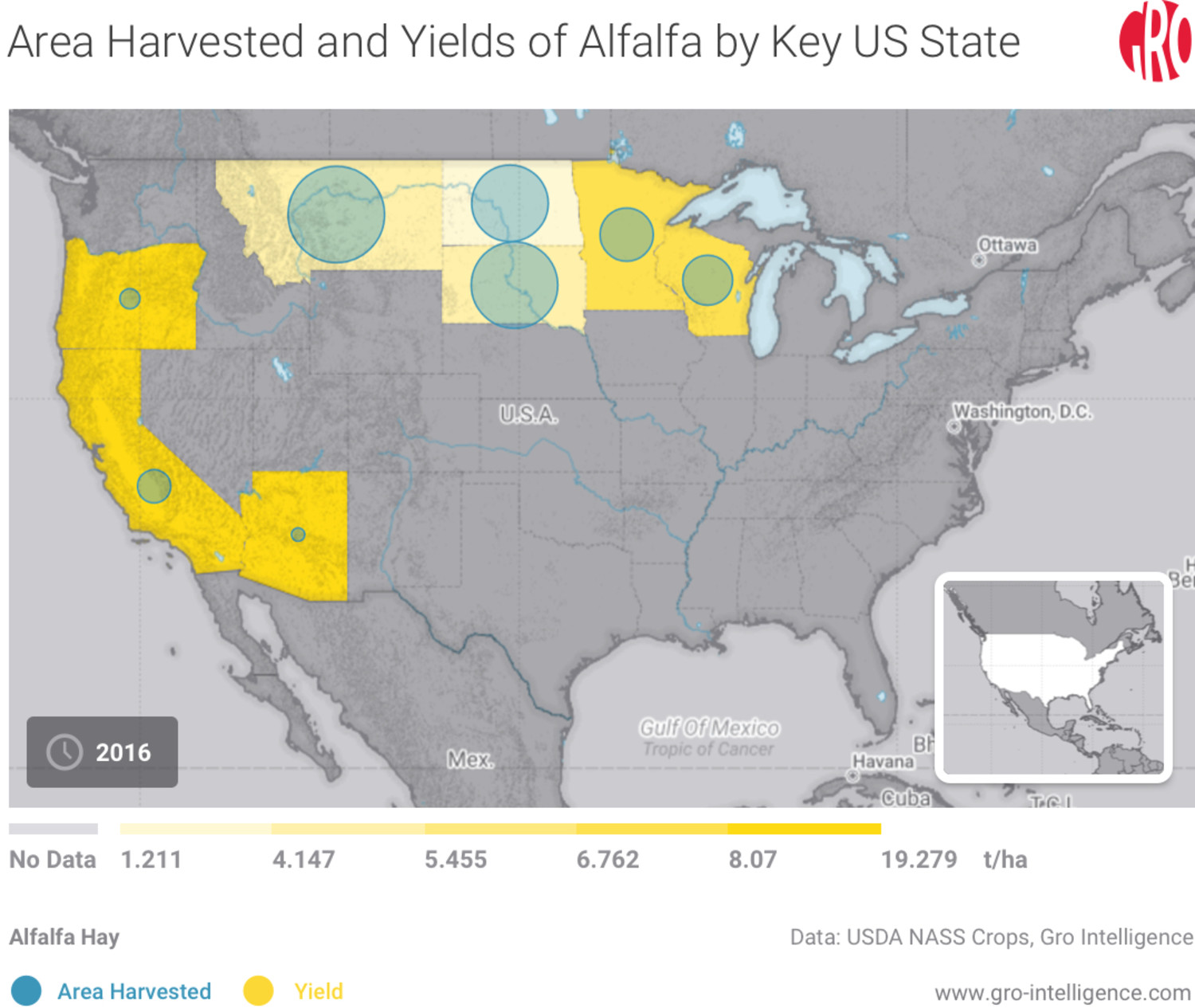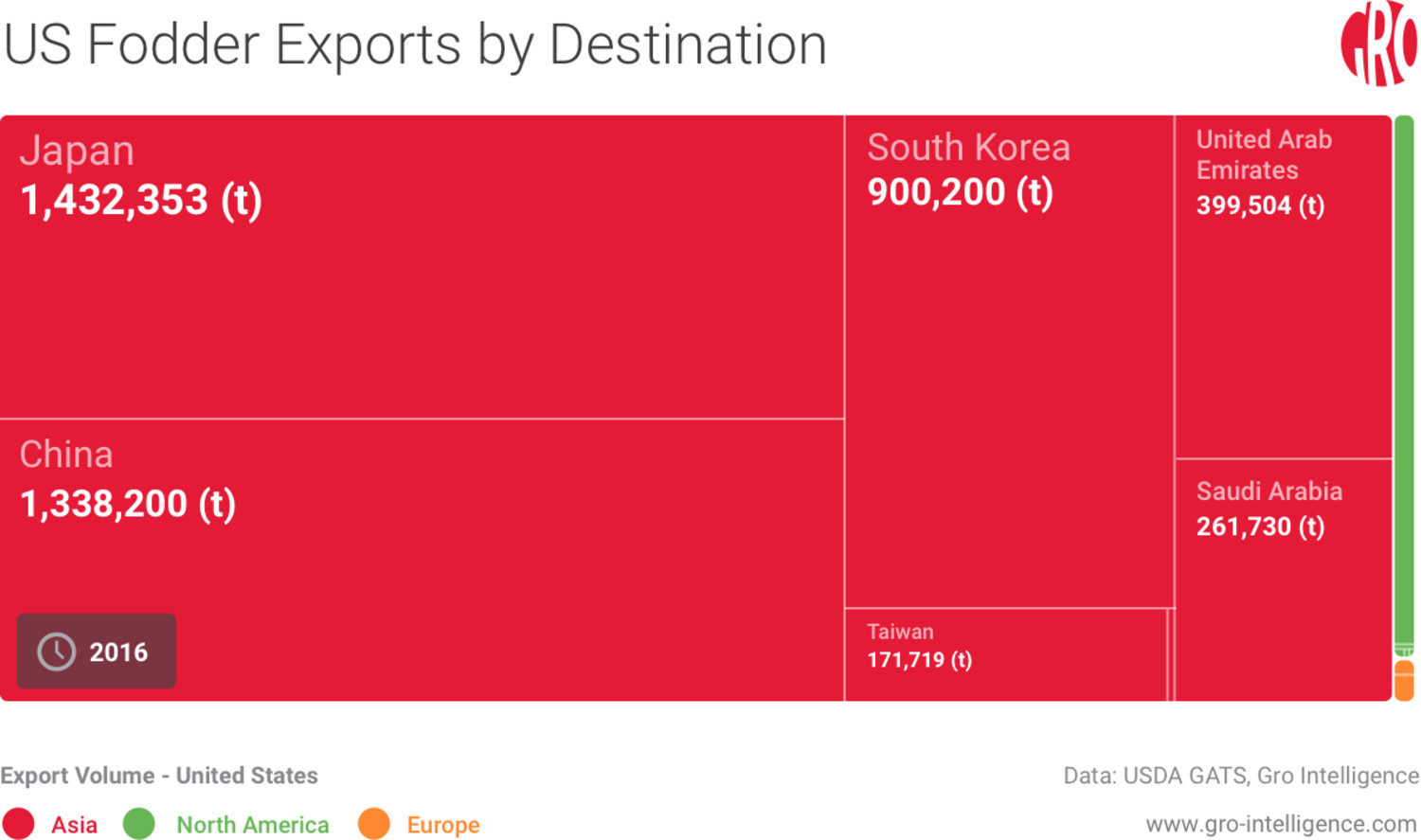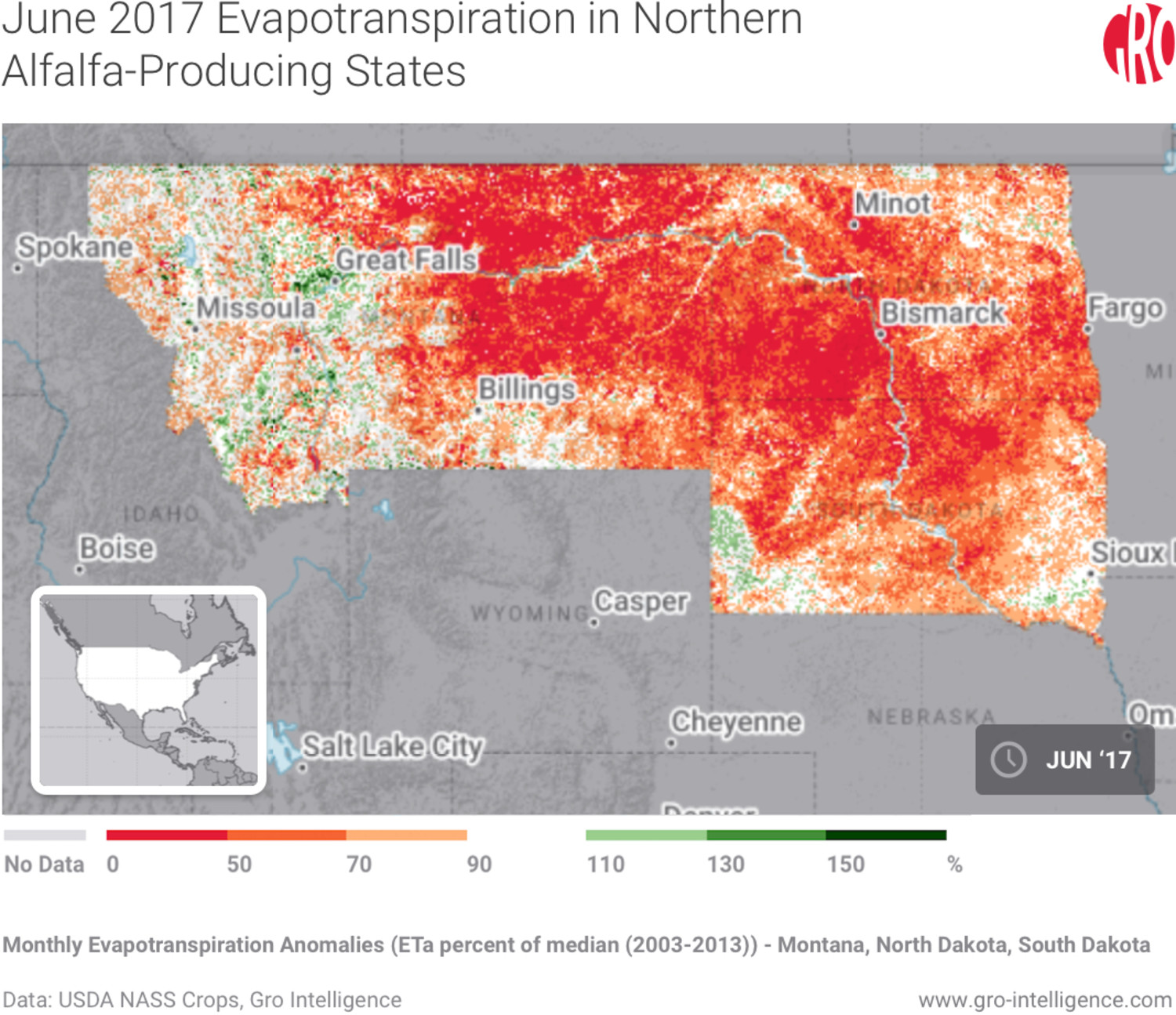Fodder for Debate: US Exports Water as Hay to Sustain Asia's Livestock
Background
Alfalfa, of the species Medicago sativa, has been an agricultural fixture as far back as 1300 BC. Ancient civilizations dating to Babylon all relied on alfalfa hay as a forage crop for their livestock herds. The domestication of alfalfa hay, among other forms of hay, removed barriers for expansion.
Alfalfa, also known as lucerne, flowed outward from the Middle East into Greece and China in 126 B.C. The forage crop spread throughout Europe by the first century A.D, but it would not become an established crop in the United States until the westward expansion to California in 1850. Alfalfa remained a warm weather crop until the introduction of hardier German varieties that were better suited for the cold. Within a century of their arrival, 30 million acres of alfalfa were planted in the US.
The modern haymaking process has remained the same even as technology has advanced. Alfalfa, grasses, clover, and green wheat or oats can be used to create hay for livestock feed. Hay is cut, and a drying process is used to quickly remove moisture from the forage. Hay is then shaped by hand or a baler to create a bundle or bale for easy transport. Hay can also be formed into pellets.
Grasslands, which include forage crops such as alfalfa, cover 26 percent of the world’s total land area and account for 70 percent of all agricultural area. The versatility and beneficial traits of alfalfa have helped it to maintain its dominance among forage crops. This is especially true in the United States where alfalfa is the main feedstock of the dairy industry.
Alfalfa’s heyday
Alfalfa is the most grown forage crop in the US. In 2016, the country’s total alfalfa crop was worth $7.5 billion compared to all other types of hay at $8.2 billion.

As of the last US ag census, alfalfa hay accounted for 16.6 million acres, or 4.27 percent of the country’s total cropland (certified organic cropland and pasture accounted for only 0.6 percent). The majority of alfalfa is consumed directly by dairy cows. In California, the country’s largest producer of alfalfa, roughly 70 percent of the state’s crop gets used that way. Beef cattle also consume increasing amounts of alfalfa to increase their fat content right before slaughter.

Since the advent of non-dormant cultivars, alfalfa is often harvested continuously and up to a dozen times per year in warmer regions. Production and yields reflect this. Of the 42 US states that produce alfalfa, large dairy states in the North and Midwest harvest the most area of alfalfa. However, limited growing seasons ensure that northern yields are among the lowest in the country. Fluctuations in climate can therefore determine the number of harvests, and thus national yields, each year.

Beyond its primary role as a feed crop, alfalfa doubles as a potent cover crop. Legumes in the family Fabaceae, including alfalfa plants, possess symbiotic bacteria, called rhizobia, in their extensive root nodules which fix nitrogen from the air into the soil. Alfalfa thereby lowers the amount of fertilizer needed for subsequent plantings by replacing nitrogen in depleted soils. The roots aerate and restructure compacted soil as well, preparing it for success in following seasons.
As recently as 2007, between 75 and 80 percent of alfalfa in top producing states has been eaten by dairy cows. Demand for feed crops differs from that for commodities that are purchased directly by consumers. As the primary forage crop for the dairy industry, alfalfa plantings are strongly influenced by local milk prices. Cold weather can also push demand for alfalfa higher. Livestock naturally burn more energy and require more feed in order to reach peak productivity in the winter. US alfalfa prices tend to peak seasonally in May.

Alfalfa abroad
Asia’s growing demand for protein has turned alfalfa into a cash crop in its own right. Before the 1990’s, Japan was the only country with a large, urban middle-class that necessitated fodder imports from the US. A large proportion of these alfalfa imports were fed to Japan’s famous Kobe and Wagyu cattle, for which alfalfa is crucial in producing the animals’ distinctly marbled beef. As other countries have begun to develop, US exports have skyrocketed. Most notably, US fodder exports to China have jumped from 2,400 to 1,338,200 tonnes in the past decade. It should be noted that these exports are significantly aided by the US trade deficit with China—containers that would otherwise return to China empty can easily and cheaply be filled with increasing amounts of alfalfa hay.


With developers bulldozing arable land in growing countries, it is likely that demand for land-intensive resources will continue to rise. Although there are several other variables, alfalfa rations are strongly correlated with improving milk cow yields. Countries such as China, Saudi Arabia, and the United Arab Emirates (U.A.E) have few resources for more dairy cows and will have to increase hay imports in order to meet increasing domestic demand.

Demand is growing so quickly that both Saudi Arabia and the U.A.E. have gone to the extreme lengths of purchasing US land to grow and ship alfalfa back across the Pacific. Almarai and Al Dahra, two dairy companies from Saudi Arabia and the U.A.E., respectively, recently purchased large plots of land in Arizona. This comes after their respective governments had placed limits on the amount of groundwater that could be drawn from their own ancient and rapidly-depleting aquifers.
Bailing water
Despite its many advantages, alfalfa’s Achilles’ heel is its nearly unparalleled thirst. In its most productive growing regions, such as the western US Sunbelt, barren soils need constant access to water in order for grasses such as alfalfa to grow. Traditionally farmers have used underground aquifers and water from the Colorado River to irrigate their crops, but recent droughts have limited the amount of discharge available for the latter. Alfalfa’s roots also grow remarkably deep, often up to 50 feet, and can reach groundwater without any help. Aquifers in the region have consequently come under significant stress.

Even before the surge in global alfalfa demand, US aquifers were being depleted at alarming rates.
Globally, agriculture is responsible for around 70 percent of all water withdrawals, and the figure is even higher in California at roughly 80 percent. Irrigating pasture for the state’s livestock uses more than 20 percent alone. Given that 100 percent of California’s alfalfa crop is irrigated and grows year round, it is less surprising that alfalfa consumes more water than any other crop in the US’s largest ag-producing state each year (even more than notoriously thirsty almond trees).
Despite most Western states having groundwater laws in place, aquifers are being steadily depleted. In California, like in many other states, recent laws are still relatively ambiguous and only loosely define groundwater sustainability. Many experts are unsure groundwater supplies will be around by the time the laws are properly defined. As one of the lowest value crops in terms of dollars per acre-foot of water, alfalfa was one of the first crops not to be replanted during the worst years of California’s recent drought. This process could drive up prices in the future.
Meanwhile, alfalfa-producing states in the West and especially the North are now experiencing a drought. In many of these states, farmers and elected officials are pressuring the government to allow hay production on federally-protected lands in the Conservation Reserve Program, signaling one of many ways the struggle for hay production may increasingly be fought as a proxy for water.

Conclusion
With its unparalleled yields and nutritional potency, alfalfa has become the crown jewel of forage crops. Yet the deep roots and nonstop growing season that make alfalfa so attractive to cultivate are also tragic character flaws. Alfalfa consumes more water than nearly any other commercial crop. With climate change and increasingly frequent droughts, ancient aquifers and snowpack-powered rivers are no longer to be taken for granted and not just in the US.
Across the ocean, rapidly developing countries such as China and Saudi Arabia are running out of both space and water. These countries now look to the US in order to satiate growing milk, dairy, and water demand. Consumers purchasing organic, grass-fed beef are also counterintuitively contributing to the problem, as those producers increasingly rely on alfalfa as a crucial finishing forage supplement.
It seems likely that Chinese growth will increasingly dictate demand for alfalfa as a global cash crop. The Chinese government has stated its desire to ramp up domestic alfalfa production, according to a recent USDA GAIN report. As of 2004, China maintains higher stocks of milk cows than the US, yet Chinese milk yields have remained just under 7 percent of those in the US. Alfalfa has been strongly correlated with improving milk cow yields, and the Chinese government is assuredly attempting to hold down the domestic price of milk in the face of skyrocketing consumption.

Whether China will be able to meet their stated goal of producing 5.4 million tonnes of alfalfa and whether they will be consuming a projected 8 million tonnes annually by 2020 will likely decide the future of US alfalfa exports in the short term. In 2016, 78 percent of China’s hay imports were from the US, and only a few other countries are poised to compete. If a lack of water in the US drives up domestic production costs substantially, other large producers like Argentina, Spain, and Uruguay may start shipping their alfalfa abroad rather than leaving it for open pasture. We see investment flowing into regions which posses suitable growing conditions for alfalfa.
Ultimately, precipitation in the Western US will be the main variable to watch. Alfalfa’s only hope, outside of a return to stable rainfall, may be its notable tolerance for high salinity, which is common in groundwater. Aquifers possess varying levels of salinity depending on their unique geological conditions, some of which may be more suited for increasing human demands rather than direct agricultural uses. If alfalfa producers can leverage this comparative advantage and plant their fields over aquifers that are unusable by other crops or humans, they will have a better chance at a sustainable future.
Groundwater resources won’t last long this way. As people continue to demand more meat and dairy, sharply rising prices of alfalfa may be just the first warnings of critically depleted aquifers. The earnings from exporting hay could end up looking pretty small next to the cost of maintaining the US’s water supply.
 Insight
InsightUS Beef Headed for Supply Shock, High Prices Through 2024, Gro Expects
 Insight
InsightUS Hogs Supplies to Shrink, Lifting Pork Prices
 Insight
InsightNew Lettuce Crop Cools Iceberg Prices but Heats Up Romaine
 Insight
Insight

 Search
Search